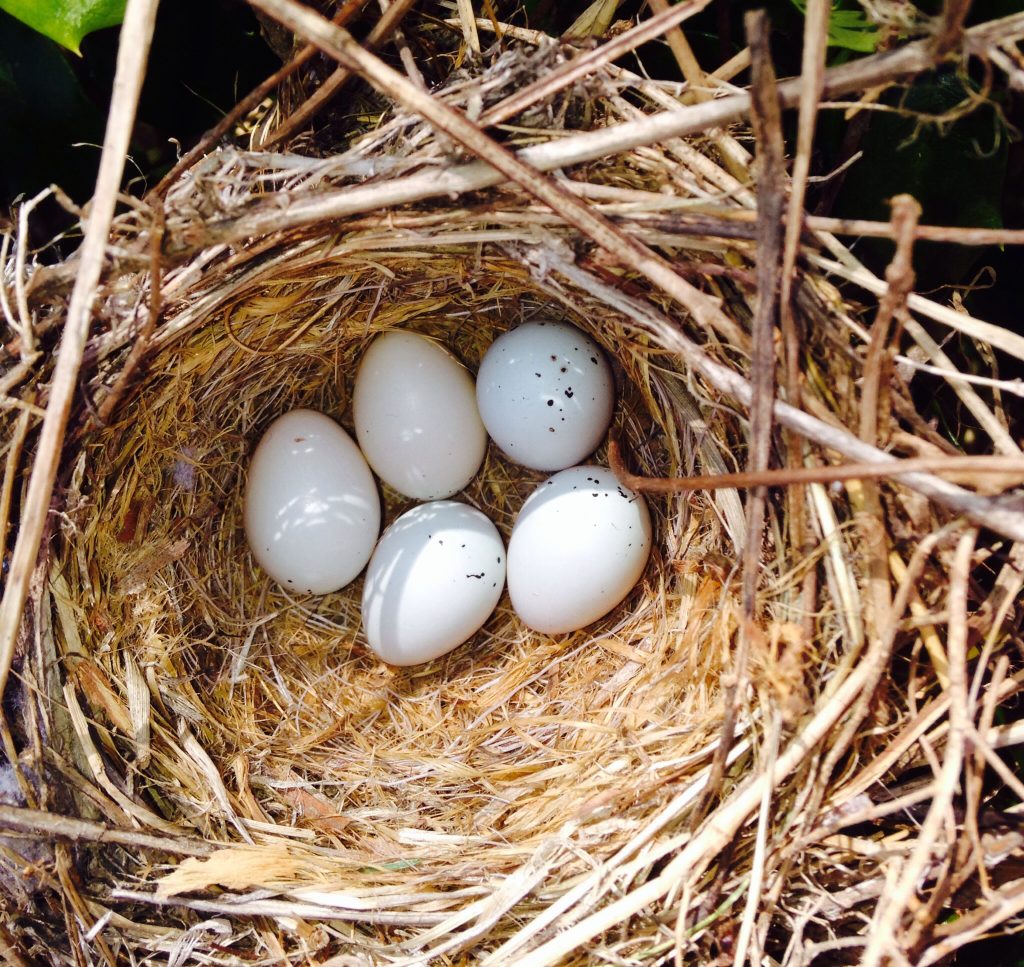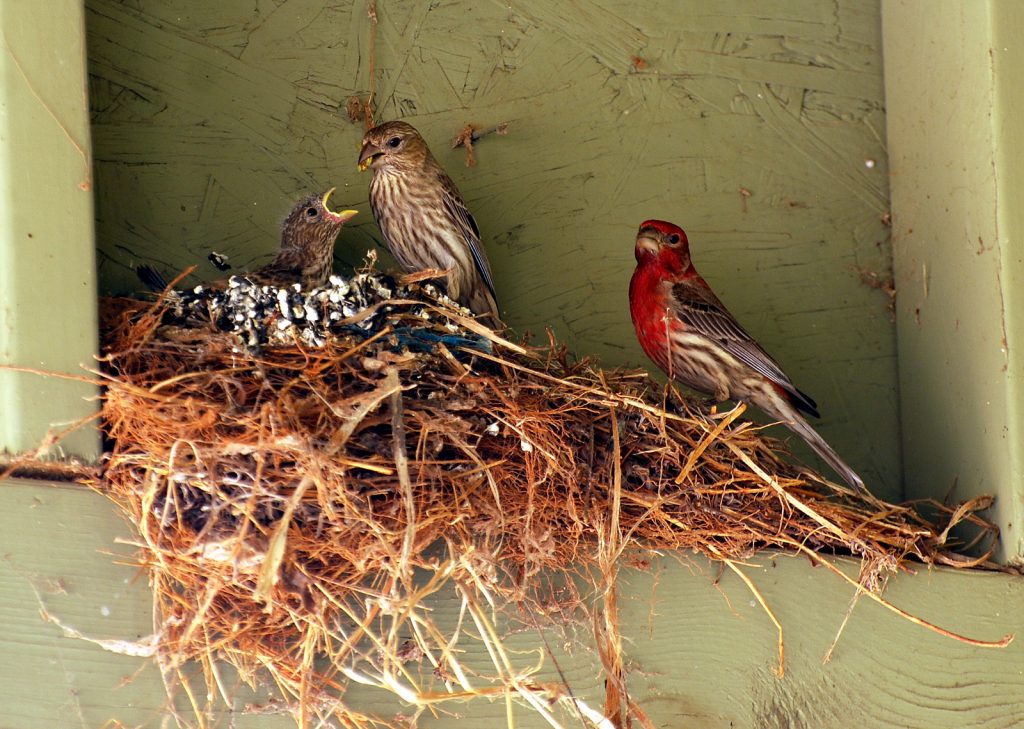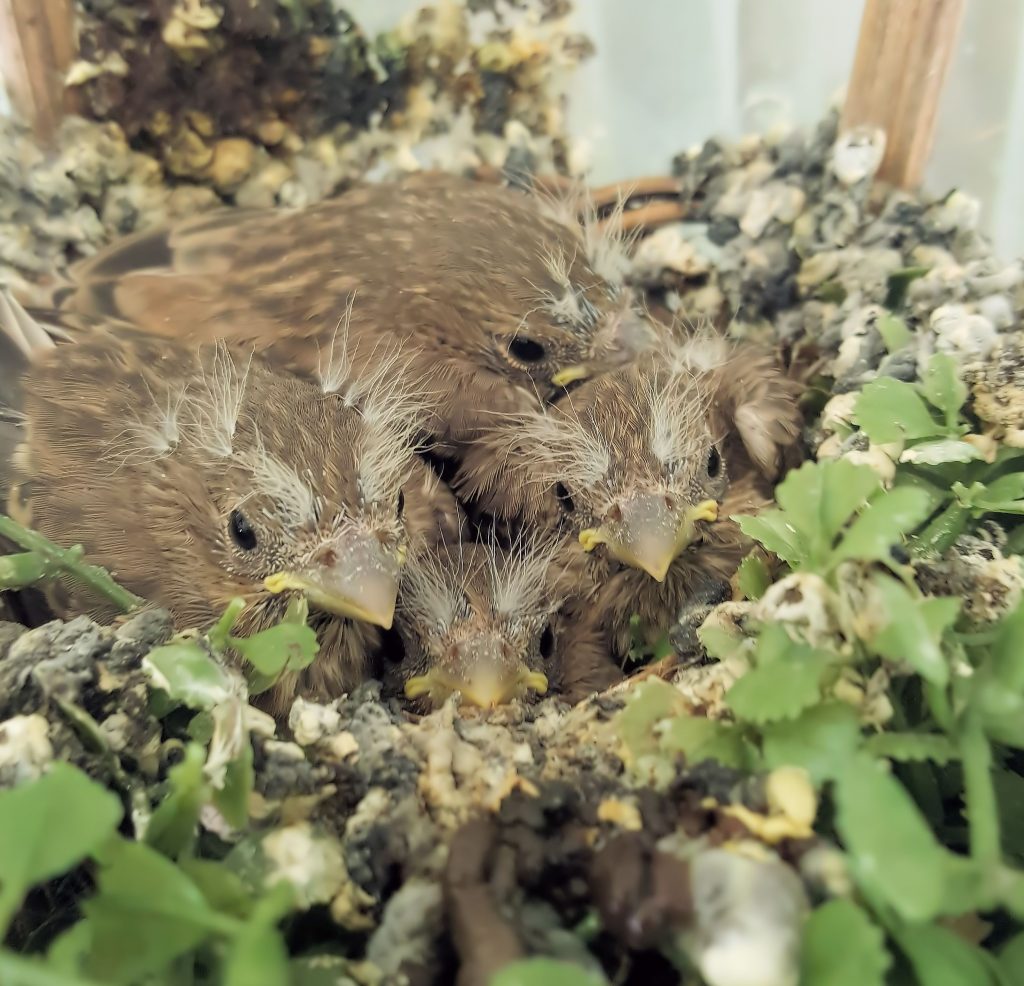Time Traveling House Finches
January 9, 2019C

A Clutch of Eggs
A clutch of five House Finch eggs holds the promise of nestlings.
From the Finch Files
In studies of the timing of nesting, it is often the insect-eaters that claim most of the research attention. After all, these birds must time their nesting activities to coincide with that of their prey species. Relatively few studies have focused on seed-eaters, perhaps because their access to bird feeders and waste grain may buffer them from spring temperature extremes to some extent. In a study lead by Heather Watts, associate professor at Washington State University, investigators wanted to know if temperature-related shifts in egg-laying dates were experienced by seed-eating species. Her team gathered around 950 nest records from multiple historic sources on California’s House Finches. About a third of the data came from NestWatch, with the remainder coming from the Museum of Vertebrate Zoology at Berkeley and the Western Foundation of Vertebrate Zoology. Altogether, the data ranged from 1895–2007 and covered most of California’s ecologically distinct regions. House Finches were an ideal study species because they are declining in California and yet still common enough to study using citizen science. And although they have been expanding their range in the eastern United States since the 1940s, they are native to California and therefore have been present in the area for the entire 113 years under study.

A Family of Finches
A male and female House Finch visit their nest to feed the young.
Focusing on Phenology
What Watts and her team found has been consistent with other recent studies on nesting phenology: the birds advanced their laying date when spring temperatures were warmer. For every 1 °C (1.8 °F) increase in average spring temperature, egg-laying started an average of 4.6 days sooner. In another recent study from California, long-term data revealed that the bird community was advancing laying dates by 5-12 days over the past century. According to Dr. Watts, whose research focuses on large-scale phenomena that are difficult to study in the field (e.g., migration, irruption, phenology), information from citizen scientists is highly valuable. In her words, “The work of citizen scientists, such as those who contribute to NestWatch, is what made this study possible. Because of the efforts of nest monitors, we are able to look at patterns over long periods of time and large geographic areas.” We are, in fact, able to travel back in time and learn from birds that lived under different climate conditions.

Preparing to Fledge
Four House Finch nestlings approach their fledging day.
Featured Findings:
- It is not necessarily temperature per se that is driving earlier nesting (as in, escaping the heat). It could be that the finches are responding to something else that is temperature-sensitive, such as the timing of seed and fruit production. This study cannot answer that question.
- In order to determine if the breeding season is actually getting longer, and to reduce bias towards early nests, it’s important to keep reporting those late-season nests. Don’t give up searching for—or reporting—nests later in the year because those nests are important too!
- The timing of egg-laying can affect other productivity measures, such as clutch size, nesting success, and egg quality. Although this study did not investigate those downstream effects, there are potentially many other consequences to nesting earlier that could be investigated in the future.
- Historic data are more relevant than ever. If you have old data that has not been archived yet, please be in touch. Sadly, researchers have not invented a time machine to enable historic nesting data collection, so we need your historic nest records.
Reference:
- Watts, H. E., D. Jiminez, V. Pacheko, and T. P. Vilgalys. 2018. Temperature‐correlated shifts in the timing of egg‐laying in House Finches Haemorhous mexicanus. Ibis: doi:10.1111/ibi.12676.
The cited research was supported by the National Science Foundation.

12 comments on “Time Traveling House Finches”
It’s definitely worth the effort to enter nesting data at NestWatch, as the nest-by-nest data can be used for bird population studies and trends.
NestWatch offers three options for entering data: At their website; with their user friendly free app; or by filling out a bulk upload form.
I had not idea my old records of nests (EAstern Bluebirds, tree Swallows, House Sparrows, Black Capped chickadees, etc., would still be of value. I have deleted a lot of records up to now. Can you be more specific about what to save?
Many of my old records also included weather data which is no longer required on NestWatch.
Hi Diana,
Please send us an email at nestwatch@cornell.edu – we are interested in your data, even if it’s only partial data! You can take a look at our Nest Check Data Sheet to see what kind of information we collect.
Hi Diana,
The short answer is, save everything! Never delete any data, as NestWatch does not keep a copy of deleted records. You can use the “archive” button to stow away data that you don’t want to see anymore. This hides it but still keeps it in our database so we can use it for research. But no, never delete your nesting data. We no longer need weather data because there are so many weather stations that have archived historical data, that there is no longer a need for the participant to enter it. As far as what old records to keep: location information, nest summary information, and nest checks can all be uploaded into NestWatch. Thanks!
Thanks, @SDBluebirds!
I watched a House Finch family started in late August 2018 in Hudson, Iowa. My first thoughts were concerns for the fledglings. No worries though as the nest was a success.
This article brought back a flood of memories! When I was an undergraduate biology major at Cornell in the mid-1970’s, House Finches were newcomers to the Ithaca area. Little was known at the time about their ability to utilize habitats different from those in their native California. I decided to do a study of their nesting behavior as an honors project for a course I was taking. I was thrilled to be able to document several nests being built in the ivy vines on campus buildings, which was certainly different from what they were used to. All of the nests had eggs in them that April when Mother Nature came calling, Ithaca style, and all of my study birds froze to death on their nests. I concluded that it was unlikely that House Finches would be successful in expanding to the North because of their early season nesting habits. How very wrong I was! Never underestimate the ability of animals to adapt.
Hi Linda, they are indeed still very successful here in Ithaca. No doubt they are helped by feeders and milder springs than you would’ve experienced in the 1970s. Thanks for sharing this memory with us!
Beginning May 1, females in my finch population began tearing up dandelion seed heads but males stayed with only the black oil sunflower seeds feeder. Why? Are dandelion seeds a good source of calcium for egg shells?
Hi Phil, American Goldfinches and House Finches prefer lots of seeds in their diet – The often prefer sunflower seeds over millet and milo, though also go after seeds found in wild plants. We don’t know of any current studies on differences of preferences between males and females. It might just be coincidence, or it might be that the males are actively preventing the females from getting to the sunflower seeds, or another factor. It’s hard to tell without a formal study. If you’d like to read more about these species, check out the House Finch and American Goldfinch pages on All About Birds (you can also search for other species). For more in-depth reading, we have available a subscription-based resource called Birds of North America (starting at $5 for 30 day access to full species accounts for all North American birds).
I have a family of house finches nesting on a wreath outside my window.in Connecticut. It’s been an amazing experience for me to watch. They are such beautiful birds! This is the first year I recall ever seeing this species.
I’ve been watching what I thought was a song sparrow all winter. Now I realize it’s the female house finch. She comes regularly to my feeders but the male I only see rarely. He’s so striking. I have lesser goldfinches and juncos galore so he really stands out. Thankyou for this wonderful article